Crop rotation is an integral part of the crop production system. The greatest benefit of rotation is increased yield, called the rotation effect. A well-planned crop rotation will also:
- help to disrupt insect and disease cycles
- reduce weed pressure
- spread workload
- aid in maintaining or improving soil structure and organic matter levels
- protect against soil erosion
- improve soil resilience against weather extremes
- provide residual nitrogen from legumes in the rotation
Continuously growing any single crop will result in the build-up of diseases and insects specific to that crop and can cause yield reductions. For example, corn rootworm populations, which have developed Bt-resistance in Ontario, accumulate after multiple years of corn in the same field. And growing back-to-back years of soybeans increases pressure from soybean cyst nematode, another yield-robbing pest. An increased frequency of low-residue soybean crops in rotation also increases the susceptibility of soil to erosion and crusting.
The greatest benefits from crop rotation come when crops from different families are grown in sequence. Field crop families include legumes (e.g., soybeans, alfalfa, edible beans), grasses like corn and cereals, and brassicas such as spring and winter canola. For example, a nitrogen-demanding grass like corn will benefit by following a nitrogen-fixing legume like alfalfa; such a sequence will also limit transfer of disease. Including warm-season (e.g., corn and soybeans) and cool-season (e.g., winter wheat) crops in rotation provides advantages in terms of workload and competition with weeds. Similarly, rotating perennials with annual crops helps to suppress weeds, break pest cycles, and build soil structure and organic matter.
Crop Rotation Improves Crop Yields and Net Returns
Winter wheat-containing crop rotations have been proven to increase corn and soybean yields relative to monocultures and corn-soybean rotations in Ontario (Figure 1). They also provide an overall economic benefit. University of Guelph research found net returns at both Elora and Ridgetown long-term rotation-tillage system trials to be higher for wheat-containing rotations (Janovicek et al., 2021). At Ridgetown, sale of wheat straw was necessary to provide the advantage (Figure 2).

Figure 1. Per cent yield increase in first-year corn and first-year soybeans in a corn-corn-soybean-winter wheat vs. corn-corn-soybean-soybean rotation between 2002-2017 (Elora), and in a corn-soybean-winter wheat vs. corn-soybean rotation between 2012-2017 (Ridgetown). Averaged across tillage treatments.
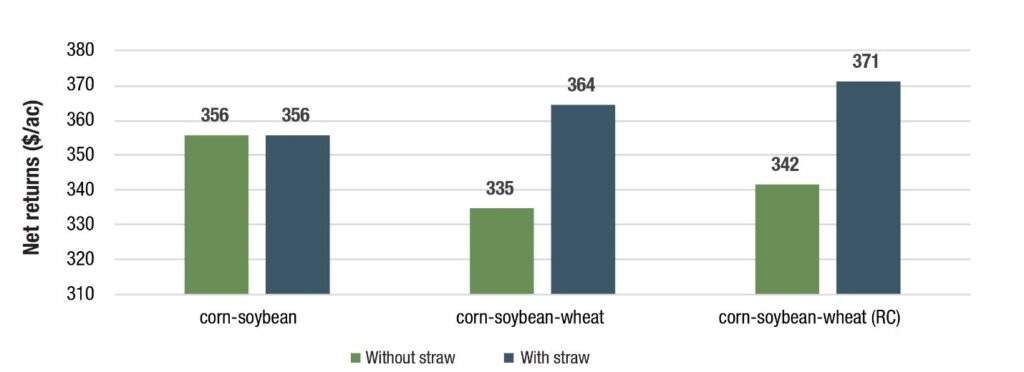
Figure 2. Average annual net returns across three different crop rotations from 2012-2017 from the long-term rotation-tillage system trial, Ridgetown, with and without straw sale. Assumes straw yield of 4 tonnes/ha (1.8 tons/ac) and cost of associated phosphorus and potassium nutrient removal.
Crop Rotation Provides Yield Stability in Adverse Years
Research from the long-term rotation-tillage system trials have also shown significant yield advantages to more diverse rotations under adverse growing conditions. Figure 3 shows the rotation effect of corn-corn-soybean-winter wheat rotations with red clover (CCSWrc) or without (CCSW) at Elora on soybean yields compared to a corn-corn-soybean-soybean rotation (CCSS) from 1982 until 2012 (Gaudin et al., 2015). Extending the crop rotation gave the greatest yield benefit (20-30%) in hot/dry seasons; it was also beneficial under cool/wet and high yielding yields.
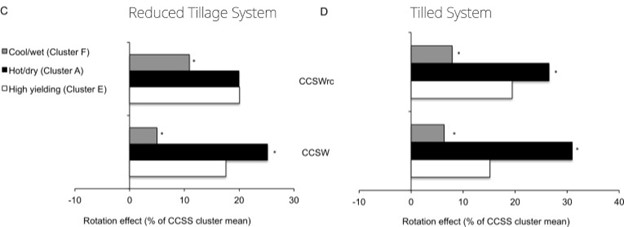
Figure 3. Rotation effect on soybean yields for wheat-based rotations at the Elora long-term rotation-tillage system trial. * indicates values significantly different from high yielding years at p = 0.05. Source: Gaudin et al., 2015.
Other research across North America has shown a yield-stability benefit from crop rotation. Across a group of 11 long-term crop rotation trials, researchers found that in drought years, corn yield losses were reduced by anywhere from 14 to 90% in more diverse rotations (Bowles et al., 2020). And a study of 20 long-term crop rotation trials determined that diversifying rotations from one to three annual crops increased income modestly under good growing conditions (by $45/acre), but really shone under poor conditions with an increased output of $165/acre (Bybee-Finley et al., 2024).
There are several explanations for why more diverse crop rotations perform better under adverse weather. Soil improvement from crop rotation can increase soil water storage through both organic matter and porosity improvements as well as greater water infiltration. Diverse crop rotations can reduce bulk density (compaction), depending on species grown. They can also enhance crop rooting through improved soil structure and spur positive changes in soil biological function. Ontario research found that rotations with small grains and cover crops reduced corn water stress; it also found a strong tie between lower corn water stress and higher levels of soil organic matter (Renwick et al., 2021).
Perennials, Small Grains, and Cover Crops in Rotation Increase Soil Organic Matter
A diverse crop rotation has generally been found to improve soil organic matter levels in the soil. This is particularly true if there are perennial forages in rotation. The Ontario Topsoil Sampling Project, which sampled topsoil across 504 sites in southern Ontario, highlights this trend. It found higher soil organic matter values in field crop systems that included a forage such as alfalfa in rotation with annual crops (Saurette et al., 2024). The highest organic matter levels were from soils with perennials only (Figure 4).
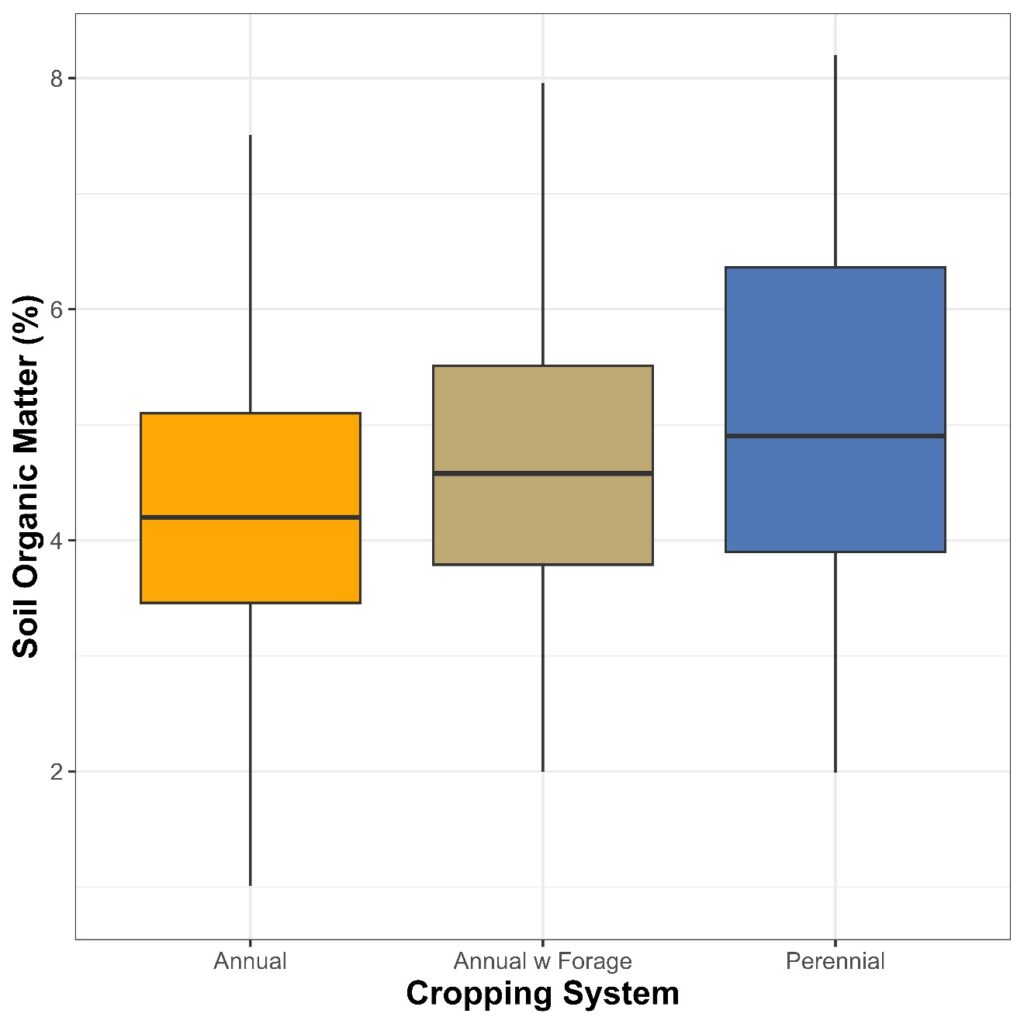
Figure 4. Soil organic matter across cropping systems sampled in the Ontario topsoil sampling project. n=1,511 (3 sample locations per site).
Cover crops and small grain cereals also play an important role. The long-term rotation-tillage system trial at Elora has shown significantly higher soil carbon levels in soils with more complex rotations, especially those that include small grain cereal crops, cover crops like red clover, and perennial forages (Figure 5). Similar results have been found in other long-term rotation trials across North America. Across 122 studies, the greatest increase in soil carbon relative to a monoculture were in rotations with at least three crops; cover crops in rotation further enhanced soil carbon levels (McDaniel et al., 2014).
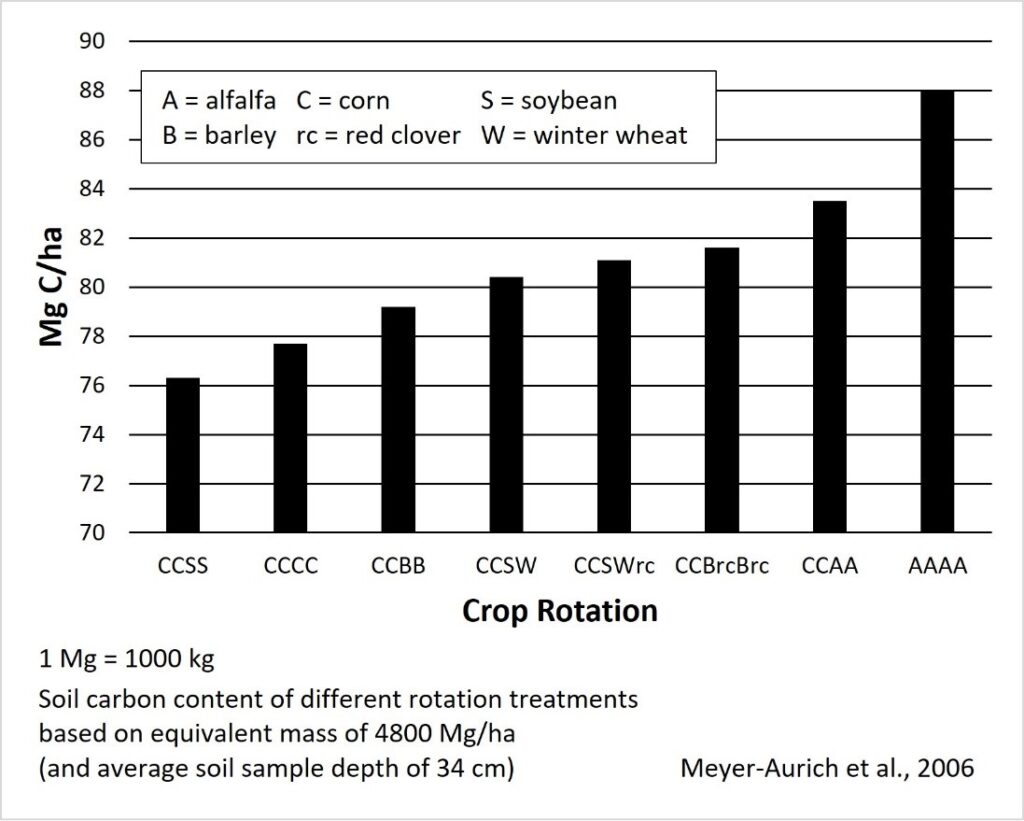
Figure 5. Impact of long-term crop rotation on soil carbon content, Elora.
Crop Rotation Enhances Nutrient Cycling and Supply
Research from the long-term rotation-tillage system trial in Ridgetown demonstrates that winter wheat in rotation reduces the maximum economic rate of nitrogen (MERN) for corn. Between 2009 and 2013, the average MERN was 16 to 30 lbs/ac less with wheat compared to a corn-soybean rotation; in other words, it took less nitrogen to produce more corn (Gaudin et al., 2015). Potentially mineralizable nitrogen – an indicator of the soil’s capacity to convert tied-up nitrogen to the plant available form of ammonium – was higher in wheat-containing rotations at Ridgetown (Congreves et al., 2015). Figure 6 shows the visual impact of this effect early in the growing season after many years of wheat in rotation.
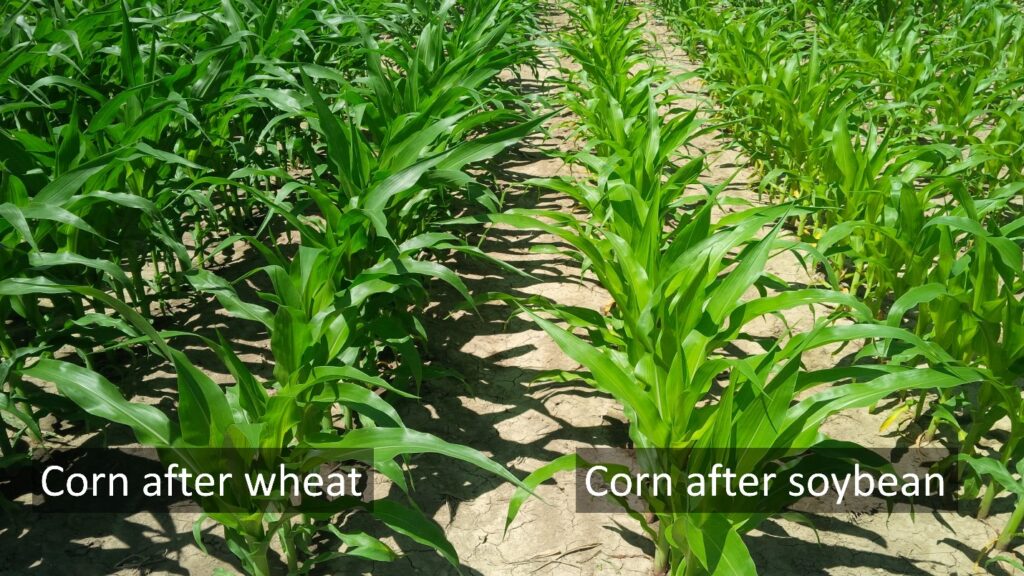
Figure 6. Corn after wheat in rotation (left) vs. after soybean (right) at the Ridgetown long-term rotation-tillage system trial. Photo: Dr. Dave Hooker.
Perennial forages, as many livestock farmers know, provide an even larger benefit to nitrogen-demanding crops like corn. Ontario fertility guidelines provide a 100 lb/acre nitrogen credit to corn following established forages with 50% or more legumes. With 1/3 to 1/2 legume content, perennial forage stands are estimated to provide 50 lbs-N/acre.
Enhancing crop rotation with cover crops
Cover crops are an important part of the crop rotation. There are several places where they can fit; one of the easiest is following winter wheat or other cereals. Seeding after silage corn, dry edible beans, and other early-harvested crops also provides good opportunities for strong establishment and growth.
References
Bowles, T.M., et al. 2019. Long-Term Evidence Shows that Crop-Rotation Diversification Increases Agricultural Resilience to Adverse Growing Conditions in North America. One Earth (2) 284-293. https://doi.org/10.1016/j.oneear.2020.02.007.
Bybee-Finley, K.A., et al. 2024. Rotational complexity increases cropping system output under poorer growing conditions, One Earth (7) 1638-1654. https://doi.org/10.1016/j.oneear.2024.07.008.
Congreves, K.A., Hayes, A., Verhallen, E.A., Van Eerd, L.L. 2015. Long-term impact of tillage and crop rotation on soil health at four temperate agroecosystems. Soil Tillage Research. (152) 17-28. https://doi.org/10.1016/j.still.2015.03.012.
Gaudin, A.M., Tolhurst, T.N., Ker, A.P., Janovicek, K., Tortora, C., Martin, R.C., Deen, W. 2015. Increasing Crop Diversity Mitigates Weather Variations and Improves Yield Stability. PLoS ONE 10(2): e0113261. https://doi.org/10.1371/journal.pone.0113261.
Janovicek, K., Hooker, D., Weersink, A., Vyn, R., Deen, W. 2021. Corn and soybean yields and returns are greater in rotations with wheat. Agronomy Journal. (113) 1691–1711. https://doi.org/10.1002/agj2.20605.
Meyer-Aurich, A., Weersink, A., Janovicek, K., Deen, W. 2006. Cost efficient rotation and tillage options to sequester carbon and mitigate GHG emissions from agriculture in Eastern Canada. Agriculture, Ecosystems and Environment. (117) 119-127. https://doi.org/10.1016/j.agee.2006.03.023.
McDaniel, M.D., Tiemann, L.K., Grandy, A.S. 2014. Does agricultural crop diversity enhance soil microbial biomass and organic matter dynamics? A meta-analysis. Ecological Applications. (24) 560–570. https://doi.org/10.1890/13-0616.1.
Saurette, D., Burns, T., Blackford, C., Warren, J., Arntz-Gray, J., Kelly, R., Jefferies, D., Munroe, J., Nemeth, D. Ontario Topsoil Sampling Project: Soil Health Baseline Study. 2024. Ontario Ministry of Agriculture, Food and Agribusiness. https://www.ontario.ca/page/ontario-topsoil-sampling-project-2024